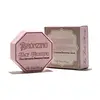What's inside
What's inside
 Key Ingredients
Key Ingredients

 Benefits
Benefits

 Concerns
Concerns

 Ingredients Side-by-side
Ingredients Side-by-side

Phenyl Trimethicone
Skin ConditioningSilica
AbrasiveAluminum Starch Octenylsuccinate
AbsorbentPolymethyl Methacrylate
Polyethylene
AbrasiveMicrocrystalline Wax
Emulsion StabilisingPhenoxyethanol
PreservativeDiethylhexyl Syringylidenemalonate
Skin ProtectingTocopheryl Acetate
AntioxidantCaprylyl Glycol
EmollientArgania Spinosa Kernel Oil
EmollientCaprylic/Capric Triglyceride
MaskingCI 77491
Cosmetic ColorantCI 77492
Cosmetic ColorantCI 77499
Cosmetic ColorantCI 77891
Cosmetic ColorantCI 42090
Cosmetic ColorantCI 17200
Cosmetic ColorantPhenyl Trimethicone, Silica, Aluminum Starch Octenylsuccinate, Polymethyl Methacrylate, Polyethylene, Microcrystalline Wax, Phenoxyethanol, Diethylhexyl Syringylidenemalonate, Tocopheryl Acetate, Caprylyl Glycol, Argania Spinosa Kernel Oil, Caprylic/Capric Triglyceride, CI 77491, CI 77492, CI 77499, CI 77891, CI 42090, CI 17200
Ethylhexyl Palmitate
EmollientIsononyl Isononanoate
EmollientPentaerythrityl Tetraisostearate
EmollientPolyisobutene
Silica
AbrasiveTridecyl Trimellitate
EmollientPolyethylene
AbrasiveSynthetic Wax
AbrasiveC12-15 Alkyl Benzoate
AntimicrobialButyrospermum Parkii Butter
Skin ConditioningTocopheryl Acetate
AntioxidantParaffinum Liquidum
EmollientGlyceryl Behenate/Eicosadioate
EmollientDiisostearyl Malate
EmollientPolymethyl Methacrylate
Hydroxystearic Acid
CleansingMethicone
EmollientSimmondsia Chinensis Seed Oil
EmollientOlea Europaea Fruit Oil
MaskingEthylhexylglycerin
Skin ConditioningPhenoxyethanol
PreservativeWater
Skin ConditioningButylene Glycol
HumectantParfum
MaskingCI 77891
Cosmetic ColorantCI 77492
Cosmetic ColorantCI 77499
Cosmetic ColorantCI 15985
Cosmetic ColorantCI 77491
Cosmetic ColorantEthylhexyl Palmitate, Isononyl Isononanoate, Pentaerythrityl Tetraisostearate, Polyisobutene, Silica, Tridecyl Trimellitate, Polyethylene, Synthetic Wax, C12-15 Alkyl Benzoate, Butyrospermum Parkii Butter, Tocopheryl Acetate, Paraffinum Liquidum, Glyceryl Behenate/Eicosadioate, Diisostearyl Malate, Polymethyl Methacrylate, Hydroxystearic Acid, Methicone, Simmondsia Chinensis Seed Oil, Olea Europaea Fruit Oil, Ethylhexylglycerin, Phenoxyethanol, Water, Butylene Glycol, Parfum, CI 77891, CI 77492, CI 77499, CI 15985, CI 77491
Ingredients Explained
These ingredients are found in both products.
Ingredients higher up in an ingredient list are typically present in a larger amount.
Ci 77491 is also hydrated iron III oxide. It's sole purpose is to give a red/pink hue to products.
Iron III oxides are classified as inorganic chemicals for coloring.
Synthetically created Ci 77491 is considered safer than those naturally found. This is because the synthetically created version may contain less impurities. Iron oxides are generally non-toxic and non-allergenic.
Learn more about CI 77491Ci 77492 is also hydrated iron III oxide. It's sole purpose is to give a yellow hue to products.
Iron III oxides are classified as inorganic chemicals for coloring.
Synthetically created Ci 77492 is considered safer than those naturally found. This is because the synthetically created version may contain less impurities. Iron oxides are generally non-toxic and non-allergenic.
Learn more about CI 77492Ci 77499 is also hydrated iron III oxide. It is created from mixing red and black iron oxides. This helps give shades of darkness to a product.
Iron III oxides are classified as inorganic chemicals for coloring.
Ci 77891 is a white pigment from Titanium dioxide. It is naturally found in minerals such as rutile and ilmenite.
It's main function is to add a white color to cosmetics. It can also be mixed with other colors to create different shades.
Ci 77891 is commonly found in sunscreens due to its ability to block UV rays.
Learn more about CI 77891Phenoxyethanol is a preservative that has germicide, antimicrobial, and aromatic properties. Studies show that phenoxyethanol can prevent microbial growth. By itself, it has a scent that is similar to that of a rose.
It's often used in formulations along with Caprylyl Glycol to preserve the shelf life of products.
Polyethylene is a synthetic ingredient that helps the skin retain moisture. It is a polymer.
It is also typically used within product formulations to help bind solid ingredients together and thicken oil-based ingredients. When added to balms and emulsions, it helps increase the melting point temperature.
This ingredient is also known as PMMA. It is a polymer microsphere, composed of tiny, perfectly spherical particles formed from repeating units.
In cosmetics, PMMA is mainly used to give a soft or blurring effect. The transparent particles are able to scatter light and help reduce the appearance of fine-lines and imperfections.
PMMA is also able to enhance the texture of products by add a smooth feel.
Learn more about Polymethyl MethacrylateSilica, also known as silicon dioxide, is a naturally occurring mineral. It is used as a fine, spherical, and porous powder in cosmetics.
Though it has exfoliant properties, the function of silica varies depending on the product.
The unique structure of silica enhances the spreadability and adds smoothness, making it a great texture enhancer.
It is also used as an active carrier, emulsifier, and mattifier due to its ability to absorb excess oil.
In some products, tiny microneedles called spicules are made from silica or hydrolyzed sponge. When you rub them in, they lightly polish away dead skin layers and enhance the penetration of active ingredients.
Learn more about SilicaTocopheryl Acetate is AKA Vitamin E. It is an antioxidant and protects your skin from free radicals. Free radicals damage the skin by breaking down collagen.
One study found using Tocopheryl Acetate with Vitamin C decreased the number of sunburned cells.
Tocopheryl Acetate is commonly found in both skincare and dietary supplements.
Learn more about Tocopheryl Acetate